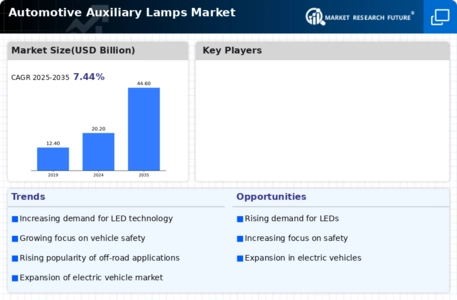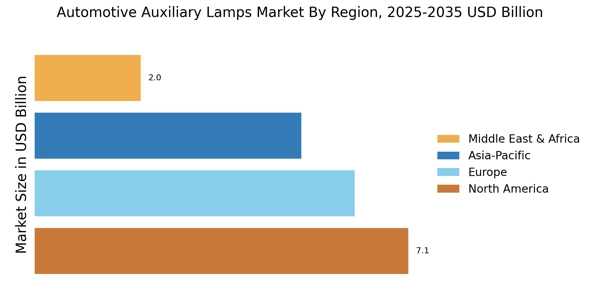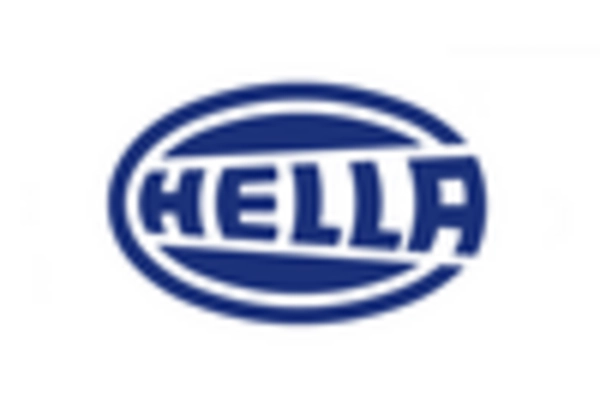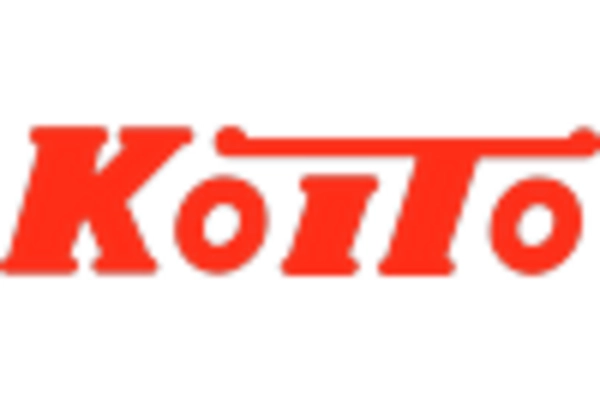Growth of the Automotive Aftermarket
The Automotive Auxiliary Lamps Market is benefiting from the growth of the automotive aftermarket sector. As vehicle owners seek to customize and enhance their vehicles, the demand for auxiliary lamps is on the rise. This trend is particularly evident in regions where off-road and recreational vehicles are popular, as consumers look for specialized lighting solutions to improve visibility in challenging terrains. Market data suggests that the aftermarket for automotive lighting is projected to grow at a compound annual growth rate of over 5% in the coming years. This growth is likely to be fueled by the increasing popularity of DIY modifications and the availability of a wide range of auxiliary lamp options. Consequently, the Automotive Auxiliary Lamps Market stands to gain significantly from this trend.
Increasing Vehicle Production and Sales
The Automotive Auxiliary Lamps Market is poised for growth due to the increasing production and sales of vehicles. As the automotive industry rebounds and expands, the demand for auxiliary lighting solutions is expected to rise correspondingly. Data indicates that vehicle production is projected to reach over 100 million units annually by 2026, which will likely drive the need for various lighting solutions, including auxiliary lamps. This trend is particularly pronounced in emerging markets, where rising disposable incomes and urbanization are leading to higher vehicle ownership rates. Consequently, the Automotive Auxiliary Lamps Market is set to benefit from this upward trajectory in vehicle production and sales.
Rising Demand for Enhanced Safety Features
The Automotive Auxiliary Lamps Market is experiencing a notable increase in demand for enhanced safety features in vehicles. As consumers become more safety-conscious, manufacturers are integrating advanced lighting solutions to improve visibility during adverse weather conditions and nighttime driving. This trend is supported by data indicating that well-lit roadways can reduce accident rates significantly. The incorporation of auxiliary lamps, such as fog lights and spotlights, is becoming a standard in many vehicle models. This shift not only enhances driver safety but also aligns with regulatory requirements aimed at reducing road accidents. Consequently, the Automotive Auxiliary Lamps Market is likely to see sustained growth as safety becomes a paramount concern for both consumers and manufacturers.
Technological Advancements in Lighting Solutions
Technological advancements are playing a crucial role in shaping the Automotive Auxiliary Lamps Market. Innovations in LED and laser lighting technologies are leading to the development of more efficient and durable lighting solutions. These advancements not only improve illumination but also reduce energy consumption, which is increasingly important in the context of rising fuel prices and environmental concerns. The market is witnessing a shift towards adaptive lighting systems that adjust brightness based on driving conditions, enhancing both safety and convenience. As these technologies become more mainstream, the Automotive Auxiliary Lamps Market is expected to expand, driven by consumer demand for high-performance lighting solutions.
Environmental Regulations and Sustainability Initiatives
The Automotive Auxiliary Lamps Market is increasingly influenced by environmental regulations and sustainability initiatives. Governments worldwide are implementing stricter emissions standards and promoting energy-efficient technologies. As a result, manufacturers are compelled to develop lighting solutions that not only meet regulatory requirements but also contribute to overall vehicle efficiency. The shift towards eco-friendly lighting options, such as LED lamps, aligns with these sustainability goals, as they consume less power and have a longer lifespan compared to traditional lighting solutions. This regulatory landscape is likely to drive innovation within the Automotive Auxiliary Lamps Market, as companies strive to create products that are both compliant and environmentally friendly.


















Leave a Comment